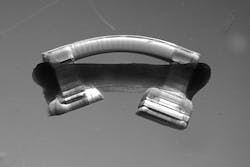Light-activated optogenetic muscles guide motion of miniature biological robots
Engineers at the University of Illinois (Champaign, IL) have developed a new class of miniature biological robots, or bio-bots, that use optogenetics to perform functions using light-stimulated muscles.
RELATED ARTICLE: Microrobots slide, crawl, and swarm into new applications
The muscle cells of these bio-bots have been genetically engineered to respond to light, giving researchers control over the bots’ motion—a key step toward their use in applications for health, sensing, and the environment. Led by Rashid Bashir, the University of Illinois head of bioengineering, the researchers published their results in the Proceedings of the National Academy of Sciences (see video below):
"Light is a noninvasive way to control these machines," Bashir said. "It gives us flexibility in the design and the motion. The bottom line of what we are trying to accomplish is the forward design of biological systems, and we think the light control is an important step toward that."
Bashir's group previously demonstrated bio-bots that were activated with an electrical field, but electricity can cause adverse side effects to a biological environment and does not allow for selective stimulation of distinct regions of muscle to steer the bio-bot, Bashir said. The new light-stimulation technique is less invasive and allows the researchers to steer the bio-bots in different directions. The bio-bots turn and walk toward the light stimulus, Bashir said.
The researchers begin by growing rings of muscle tissue from a mouse cell line. The muscle cells have a gene added so that a certain wavelength of blue light stimulates the muscle to contract, a technique called optogenetics. The rings are looped around posts on 3D-printed flexible backbones, ranging from about 7 mm to 2 cm in length.
"The skeletal muscle rings we engineer are shaped like rings or rubber bands because we want them to be modular," said graduate student Ritu Raman, the first author of the paper. In addition to the modular design, the thin muscle rings have the advantages of allowing light and nutrients to diffuse into the tissue from all sides. This contrasts with earlier bio-bot designs, which used a thick strip of muscle tissue grown around the skeleton.
The researchers tried skeletons of a variety of sizes and shapes to find which configurations generated the most net motion. They also exercised the muscle rings daily, triggering the muscle with a flashing light, to make them stronger so that the bots moved farther with each contraction.
"This is a much more flexible design," Bashir said. "With the rings, we can connect any two joints or hinges on the 3-D-printed skeleton. We can have multiple legs and multiple rings. With the light, we can control which direction things move. People can now use this to build higher-order systems."
SOURCE: University of Illinois;https://news.illinois.edu/blog/view/6367/338997
About the Author

Gail Overton
Senior Editor (2004-2020)
Gail has more than 30 years of engineering, marketing, product management, and editorial experience in the photonics and optical communications industry. Before joining the staff at Laser Focus World in 2004, she held many product management and product marketing roles in the fiber-optics industry, most notably at Hughes (El Segundo, CA), GTE Labs (Waltham, MA), Corning (Corning, NY), Photon Kinetics (Beaverton, OR), and Newport Corporation (Irvine, CA). During her marketing career, Gail published articles in WDM Solutions and Sensors magazine and traveled internationally to conduct product and sales training. Gail received her BS degree in physics, with an emphasis in optics, from San Diego State University in San Diego, CA in May 1986.
